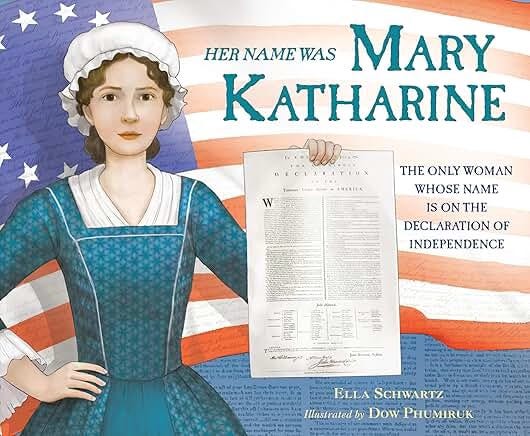A Surprising Fact about the Declaration of Independence
Her Name Was Mary Katharine: The Only Woman Whose Name Is on the Declaration of Independence
Mary Katharine Goddard enjoyed growing up in a busy seaside town in Connecticut when it was a colony under the rule of the British king. Though it was uncommon for girls to be educated in the same manner as boys in the mid-1700s, Mary Katharine’s parents encouraged her to study Latin, history and literature just as they had her brother William. After their father’s death, their mother moved the family to Providence, Rhode Island, where William opened a print shop—establishing the Providence Gazette, the first newspaper in Providence.
Newspapers were important in the colonies, providing information that people needed about what was taking place in their community and the wider world. With William often traveling, Mary Katharine learned all the aspects of printing. When the British Parliament imposed a tax on printed paper, Mary Katharine made sure the Providence Gazette published the colonists’ protests.
Tiring of Providence, William moved to Philadelphia. Mary Katharine and her mother followed, where once again Mary Katharine took charge of printing William’s newspaper, the Pennsylvania Chronicle. Yet again, William moved—this time to Baltimore, establishing the Maryland Journal, and the Baltimore Advertiser. Ever loyal, Mary Katharine came to Baltimore to run those papers!
William was always preoccupied with things other than the printing business, but knowing there was important news to print, Mary Katharine faithfully recorded the continuing tensions between Britain and the colonies. She wrote and published strong opinions about taxation without representation and the importance of liberty over servitude. Even after the battles of Lexington and Concord in April, 1775 (which marked the beginning of the Revolutionary War), Mary Katharine continued to publish the Maryland Journal regularly. With her brother paying little attention to the paper, she finally decided to take credit for her work, signing the paper “Published by M. K. Goddard,” not revealing the fact that she was a woman.
Then, on July 4, 1776, a handwritten copy of the Declaration of Independence was approved by the Continental Congress. It bore no signatures, as the document was an act of treason punishable by death. When the Continental Congress moved to Baltimore, Mary Katharine was put in charge of printing congressional documents while still running the Maryland Journal, which remained a vital source of news.
When the Continental Congress decided to print a new edition of the document and to bravely include the names of the signers, the job of designing and printing was given to Mary Katherine, “a trusted fellow patriot.” The Declaration of Independence “would announce the birth of a new nation and was intended to be preserved forever for future generations.” It was an important job, and Mary Katharine carefully and skillfully set the type. Then she added, at the very bottom, the printing credit “Baltimore, in Maryland – Printed by Mary Katharine Goddard”—the only woman’s name appearing on an official copy of the Declaration.
Her Name Was Mary Katharine: The Only Woman Whose Name Is on the Declaration of Independence, by Ella Schwartz, is a fascinating account of a determined patriot. It ends with an Author’s Note providing more details about William, Katharine, and aspects of the times as well as a glossary of terms. Illustrations by Dow Phumiruk will draw readers in, capturing the historical setting and amplifying the intriguing text.
Ages 5-9. Christy Ottaviano Books / Little, Brown Books for Young Readers, 2022.
You can view a digital copy of the Declaration of Independence at the Library of Congress, showing Mary Katharine’s name at the bottom.





